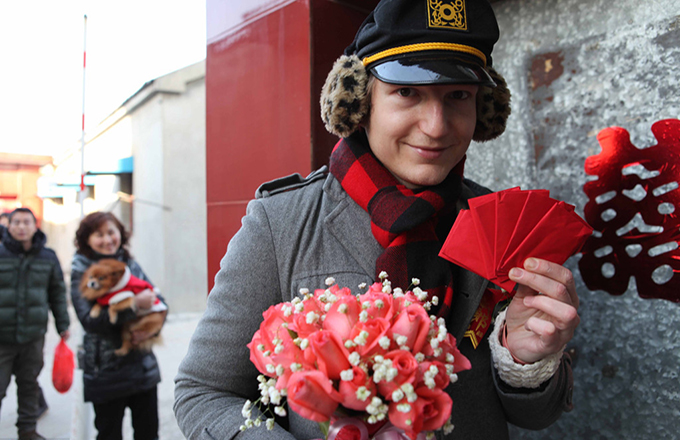Discovering Shanxi
My first taste of Shanxi was in 1995 when I took on the role of English teacher at Shanxi University. For the next two years, I travelled throughout Shanxi and become enchanted by her ancient history and culture. In October, 2004 I returned with my family to work for a non-government organisation (NGO) based in Taiyuan. While there, I worked, studied the language and again spent time studying the history of the area.
Shanxi is an amazing place. To some it may be a backward, polluted place full of coal mines and people with either too much money or too little. The perception of Shanxi is truly a mixed bag. But I have felt the embrace of hospitality that has made Shanxi my (老家) home. Activities to promote Shanxi and allow foreigners to visit is a brilliant idea.
I left work in late September and flew to Taiyuan where I first met my good friend Wang Hong at his coffee shop, Maya, near Kaihuasi 开化寺. Maya was one of the places in Taiyuan that became a second home. Those Chinese friends whom we spent our holidays with, drank coffee together and celebrated our kids' birthdays have done more for our understanding of China than any cultural studies could do. When we return to Shanxi, we return to family.
On Saturday morning, I headed back to Maya and sat outside the coffee shop enjoying the sunshine and cool breeze and reminisced about old times. There I took a picture and posted it on Twitter, Facebook and Instagram and many old friends who used to work in Shanxi thanked me for the fond memories of Maya.
That afternoon, I met with the China Daily staff and other foreign participants. We took a bus to the Fen River and Binghe Park to enjoy the scenery. Afterwards, we headed to the Shanxi Huiguan to enjoy Shanxi's various styles of noodles and take in more of Shanxi's special food and culture.
On Sunday, we headed north on the expressway for Daixian County to see a Confucian Temple from the Tang Dynasty, a Ming Drum Tower in the center of the city and a Yuan Dynasty Temple. Late that afternoon, we travelled to Yan Men Guan, a portion of the Great Wall which has been rebuilt in the last five years or so. Unfortunately, much authenticity has been lost. It has more of a Disney feel, complete with an electronic shooting range, a dancing performance and other attractions. It is a shame that much of the grandeur and wonder of this ancient feat has been lost at Yan Men Guan. This begs the question: how will China celebrate and maintain its history while preserving its heritage? Later, travelling to Ying Xian county to see Fo Gong Si temple, which has no metal nails and is nearly 1000 years old, I chatted with our guide. He said that he saw the temple every day on his way to school but never thought anything of it until he came back as an adult. In fact, he had never even been inside. Now the second floor is tilting slightly, forcing major renovations and no one can go up into the tower. Twenty years ago, I was able to climb up into it. I remember looking down on a sleepy Chinese village. So much has changed.
That night, we arrived at our hotel in Datong, another city with a fascinating history. From Datong, we headed to Yungang Grottoes. Twenty years ago I was blown away by what I saw at Yungang. Some of the grottoes rival the Sistine Chapel for their intricate work and paintings which are from the late 400s AD. Back then, I remember hundreds of coal trucks plying the roads between Datong and the grottoes and there was so much coal dust on the side of the road that people were shoveling the coal dust into vehicles for personal use. This has changed too. The roadside is now beautiful and green. After Yungang, we headed to the Nine Dragon Wall in Datong and then on to De Sheng Fort, one of the many garrison forts strategically stationed all over northern Shanxi.
At its height, De Sheng Fort had 3,000 men and 1,000 war horses stationed there during the Ming Dynasty. From De Sheng, one can see the old Ming Great Wall snaking over the hills interspersed with signal towers. About 3 kilometers north is De Sheng Kou, or Victory Gate, which at the time of its building would have been the frontier. We were able to walk over to Inner Mongolia and see the original Great Wall with pieces of irrigation canals from the 1950s or 60s.
That night it turned cold. From Datong, we headed south to Heng Shan to the Hanging Temple in Hun Yuan County. I was here on my own 20 years ago but never got a chance to go into the temple. This time I did. Twenty years ago there was a village at the base of the temple. Now it's a parking lot and tourist area. The Hanging Temple is truly an architectural wonder and nearly 1,500 years old. We headed back into Hun Yuan to see a tourist area being built in four different historical styles and then to Yong An Si temple to see the best preserved frescos from the Yuan Dynasty. According to our guide, emperor Kangxi had the frescos restored sometime in the late 17th century. Unfortunately, many of the Buddhist statues inside the temple were removed in the mid 1960s to store grain.
The trip was truly amazing and gave me a huge appreciation again for the history of Shanxi and what wonders it holds. Shanxi truly has much to offer the world and much that should be seen and preserved because its ancient history and culture is something that is celebrated and intriguing to foreign eyes.




















